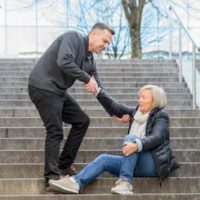Five Common Older Adult Fall-Related Injuries

Medicare and Medicaid pay more than half of the $50 billion a year in medical expenses related to older adult falls. In other words, you and I pay these costs, in the form of higher taxes and premiums. Fall injury survivors have already been victimized once. The responsible party, which is usually the property owner, should accept financial responsibility for these falls. Other people shouldn’t pay for an owner’s negligence, and victims shouldn’t have to depend on government assistance.
If the owner had a duty of care and the owner knew about, or should have known about, the fall injury hazard, a Seattle slip and fall lawyer can hold the owner financially responsible not only for medical costs, but also for other economic losses, such as lost wages, as well as noneconomic losses, such as pain and suffering..
Head Injuries
The brain isn’t much bigger than two clenched fists, and the skull is obviously much bigger. So, the motion of a fall, as opposed to the landing, often causes head injuries. When people fall, their brains slam against the insides of their skulls. This impact causes brain bleeding and swelling.
Head injuries are also difficult to diagnose. Since the brain conceals its own injuries, many fall victims tell emergency responders, and even their own doctors, that they “feel fine.” Therefore, these professionals often do not aggressively follow up, and victims go home with severe head injuries that are getting worse by the second.
Broken Arms and Shoulders
When victims fall, they naturally extend their arms to break their falls. Older adults often have pre-existing conditions, like arthritis, that weaken their bones. So, their arms cannot possibly absorb the force in a fall.
The breaks are so serious that doctors normally insert pins, plates, and other metal parts to reconstruct the bones. Frail victims usually cannot tolerate aggressive procedures, which means doctors must spread the reconstructive surgery out over multiple procedures.
Doctors do their best and so do physical therapists. These professionals know how to strengthen muscles. But despite their best efforts, these victims usually have permanent injuries, such as lost mobility in a shoulder.
Insurance companies cannot use arthritis or other pre-existing conditions as an excuse to reduce or deny compensation. The eggshell skull rule, which basically states that defendants take victims as they find them, usually applies in these cases.
Internal Injuries
The aforementioned motion often causes internal organs to violently grind and bump against each other. These organs don’t have protective skin layers. Therefore, a minor abrasion usually bleeds badly.
Internal bleeding is hard to detect and even harder to stop. In fact, by the time they reach hospitals, many elderly fall injury victims have already gone into hypovolemic shock.
Fear
Negligence defendants are responsible for emotional injuries as well as physical ones. Many older adult fall victims are so afraid of falling again that they adopt sedentary lifestyles. The inactivity further atrophies their muscles and affects their reflexes, leaving them more vulnerable to a repeat fall.
Spine Injuries
A spine is a long chain of nerves and vertebrae. Any jostling could knock the spine out of alignment. To avoid permanent paralysis, these victims have few options, other than additional risky and invasive surgical procedures.
Count on a Savvy King County Lawyer
Property owners have safety responsibilities. For a free consultation with an experienced personal injury lawyer in Seattle, contact the Emerald Law Group. Attorneys can connect victims with doctors, even if they have no insurance or money.
Source:
cdc.gov/falls/data/fall-cost.html
